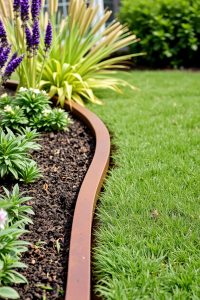
10 Stylish Garden Edging Ideas for a Beautiful Outdoor Space
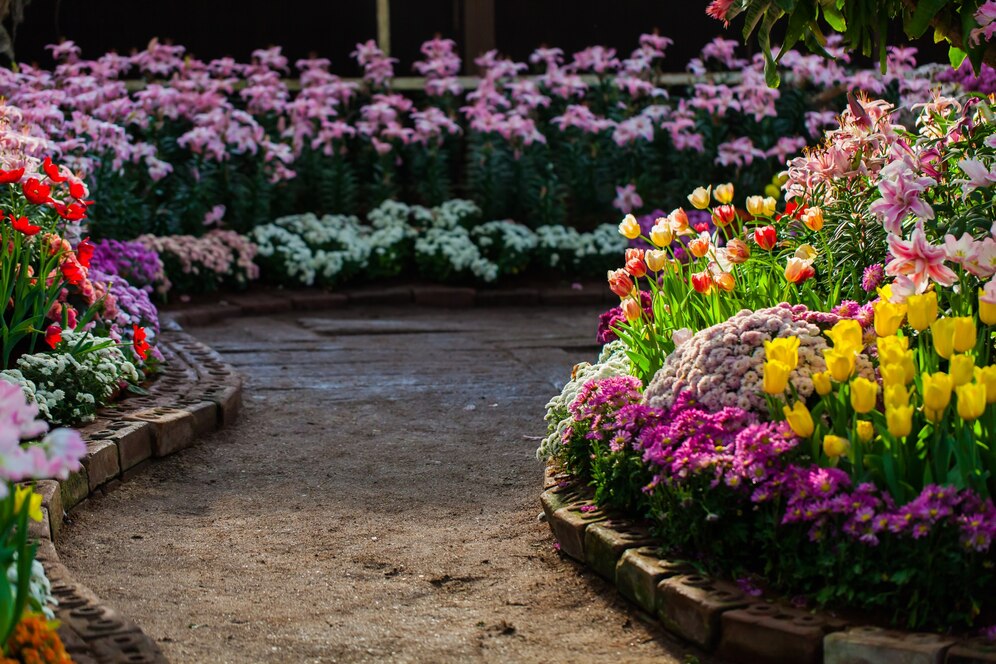
A well-edged garden creates a clean, defined look that adds beauty and structure to your outdoor space. Garden edging not only helps separate flower beds from lawns, but it also prevents soil from spilling into walkways or other areas.
With the right edging ideas, you can highlight your plants and give your garden a polished finish. The best part? Garden edging comes in many styles, so you can easily match it to your garden’s overall design.
Whether you want something natural and rustic or sleek and modern, there are plenty of ways to make your garden edges stand out. From simple stone borders to unique metal designs, you’ll find an edging style that fits your garden’s personality and enhances its beauty.
Let’s explore 10 creative garden edging ideas to inspire your next outdoor project.
10 Creative Garden Edging Ideas to Enhance Your Outdoor Space
A well-edged garden adds both beauty and structure to any outdoor space. It defines the lines of your garden, keeps the soil in place, and creates a polished look.
Edging is not just practical; it’s a key design element that can transform your garden. Whether you want something simple or elaborate, the right edging can enhance your landscape’s appeal.
The possibilities are endless, with different materials and styles to choose from. In this blog, we will explore 10 creative garden edging ideas that will make your outdoor space stand out.
1. Stone Garden Edging
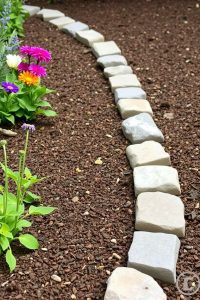
Stone is one of the most popular choices for garden edging. It’s natural, durable, and works well in almost any garden style. You can use flat stones for a neat, uniform edge or mix different sizes for a more rustic look.
For a more refined appearance, stack the stones in a straight line. To keep them in place, you can secure the stones with a little mortar or soil.
This timeless look works well for flower beds, pathways, and vegetable gardens.
2. Wooden Border Edging
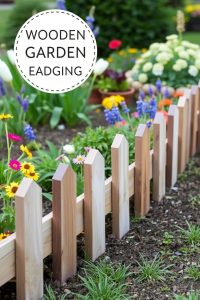
Wooden garden edging offers a natural, warm look to your garden. It’s also very affordable and easy to install. You can use timber planks, railroad ties, or wooden stakes to create a border.
For a more rustic vibe, untreated wood looks great, but for durability, consider pressure-treated lumber. This option pairs well with cottage-style gardens and can easily be adapted to different shapes and designs.
3. Metal Garden Edging
Metal edging offers a sleek, modern look. It’s especially useful for creating sharp, defined lines between your garden and lawn.
Materials like steel or aluminum can withstand the elements, making them a long-lasting choice.
Metal edging is ideal fo
r creating clean, straight lines along garden beds or paths. For a more elegant look, you can choose a rusted finish or paint the metal in a color that matches your garden theme.
4. Brick Edging

Bricks offer a classic, sturdy option for garden borders. Whether laid flat or stacked upright, bricks can create a strong, durable edge. They are especially useful for separating different garden zones, such as flower beds and walkways.
Bricks come in many styles and colors, so it’s easy to match them to your garden’s aesthetic. Lay them in a simple, straight line for a clean look, or get creative by arranging them in a herringbone pattern.
5. Plastic or Rubber Edging

Plastic or rubber garden edging is an affordable and low-maintenance option. It’s available in various styles and sizes, making it easy to find the right one for your garden.
This material is flexible, so it can easily be shaped into curves and bends to follow the natural lines of your garden. Plastic edging can be installed quickly, and it’s perfect for homeowners who want a hassle-free solution.
6. Gravel Edging
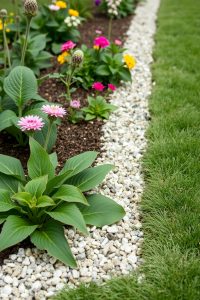
Gravel is another great option for edging that adds texture and contrast to your garden. It’s especially useful for creating informal, relaxed garden borders.
You can line a trench with gravel to separate your garden from the lawn, or use it around the base of plants to create a neat appearance.
Gravel is also a good option for preventing soil erosion in areas with sloping terrain. Make sure to use a weed barrier underneath to prevent weeds from growing through the gravel.
7. Corten Steel Edging
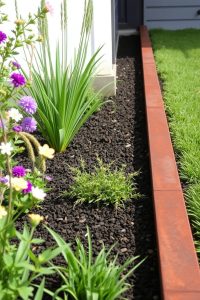
Corten steel has a unique, weathered look that adds character to your garden. As the steel ages, it develops a rich, rust-colored patina, which makes it perfect for rustic or industrial-style gardens.
Corten steel edging is durable and resistant to corrosion, ensuring it will last for years. This material works well for creating modern or minimalist borders and can be used for both straight and curved edges.
8. Concrete Garden Edging

Concrete is a versatile material for garden edging that can be molded into various shapes. It offers a clean, modern look and works well for both straight and curved borders.
Concrete can be poured into molds to create custom shapes, or you can use pre-cast concrete blocks. While it’s a more permanent option, concrete is long-lasting and can withstand the elements.
You can paint or stain concrete to match your garden design or leave it in its natural gray state for a minimalist look.
9. Plastic Edging with Decorative Features
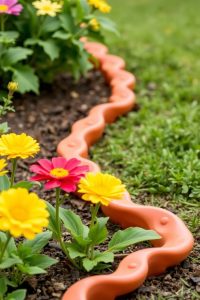
If you’re looking for something both functional and decorative, consider plastic edging with built-in features like flower patterns or scalloped edges.
These types of edgings are often available in a variety of colors and designs, so you can choose one that complements your garden theme.
They are easy to install, lightweight, and affordable, making them a popular choice for DIY gardeners. Decorative plastic edging works well for flower beds, vegetable gardens, and around shrubs.
10. Living Edging (Plants and Shrubs)

For a natural, organic border, consider using living plants or shrubs as edging. You can create a living fence or hedge by planting low-growing plants, such as lavender, boxwood, or creeping thyme, along the edge of your garden.
Not only does this add beauty, but it also helps create a natural boundary. Living edging requires some maintenance, like pruning, but it offers a unique and eco-friendly alternative to traditional materials.
FAQs
1. What is the best material for garden edging?
The best material depends on your garden style and budget. Stone, brick, and metal are popular choices for their durability and aesthetic appeal. For a budget-friendly option, plastic or rubber edging works well.
2. Can I create curved edges with garden edging?
Yes! Many materials, like plastic, metal, and even gravel, can be shaped into curves to follow the natural lines of your garden.
3. How do I prevent weeds from growing through my garden edging?
To prevent weeds, lay a weed barrier or landscape fabric underneath your edging material. This will help block weed growth while allowing water to pass through.
4. How do I install garden edging?
Installation methods vary by material. For stone or brick edging, you may need to dig a trench, level the ground, and lay the materials in place. For plastic or metal edging, simply insert the material into the soil and secure it with stakes.
5. Is garden edging expensive?
The cost of garden edging varies depending on the material. Wooden and plastic edging are generally more affordable, while stone, metal, and brick may cost more due to their durability and aesthetic value.
Conclusion
Garden edging not only enhances the appearance of your outdoor space but also helps define areas within your garden, making it look well-organized and tidy.
From traditional stone and brick to modern metal and concrete options, there’s an edging style to suit every taste and budget. Whether you prefer a sleek, minimalistic look or a more natural, organic border, you can choose the perfect material to bring your garden vision to life.
Keep in mind that maintenance requirements, such as weeding and upkeep, will depend on the type of edging you select. With these 10 creative garden edging ideas, you can easily upgrade your garden and create a visually appealing, functional outdoor space.

